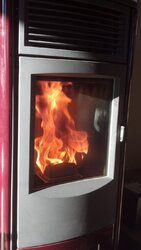- May 19, 2013
- 205
I finished my first bag of pellets and I'm on to the second brand now. What characteristics and feedback do you look for in order to determine if a pellet is better or worse for your stove?
The first bag I used was Tiny T'Embers which uses urban clean wood waste to make their pellets. Excerpt From their site: "cut-offs from truss manufacturers, framing contractors, pallet manufacturers, and many other businesses that have clean wood waste available."
That bag turned the glass dark black from head to toe within an hour and the burn was inconsistent and sometimes incomplete.
The second bag that I'm currently burning is the Home Depot re-branded bag of Forest Energy's which is a softwood out of Arizona. Compared to the wood waste bag I've noticed that the glass has approx 70% less soot on the glass and the pellet ash is not leaving any larger pieces in the ash bin. What about BTU content? How are you determining if one pellet brand burns hotter than the next?
The first bag I used was Tiny T'Embers which uses urban clean wood waste to make their pellets. Excerpt From their site: "cut-offs from truss manufacturers, framing contractors, pallet manufacturers, and many other businesses that have clean wood waste available."
That bag turned the glass dark black from head to toe within an hour and the burn was inconsistent and sometimes incomplete.
The second bag that I'm currently burning is the Home Depot re-branded bag of Forest Energy's which is a softwood out of Arizona. Compared to the wood waste bag I've noticed that the glass has approx 70% less soot on the glass and the pellet ash is not leaving any larger pieces in the ash bin. What about BTU content? How are you determining if one pellet brand burns hotter than the next?






 . 176-353
. 176-353